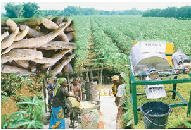Afrique en ligne - Angers,France
News - Africa news Nov. 27, 2008
Lagos, Nigeria - Scientists working at the Nigeria-based International Institute of Tropical Agriculture (IITA) have developed a new cassava flash dryer machine that will help cassava farmers and processors earn bigger profits and get better-quality product, according to a statement from the organisation.The statement, obtained by PANA here Wednesday, said that the machine was developed in collaboration with some other partners
''Aside from higher production capacity, the new flash dryer also consumes less fuel, using only 12 liters of diesel per hour to produce 250 kg of flour. Comparatively, current models burn about 20 liters of fuel per hour to produce only 80 kg of flour,'' the statement said.
According to the research institute, the new machine is said to be cost-effective and efficient, capable of producing 300% more flour while using 40% less fuel.
Most models being used by cassava millers in Nigeria are imported, usually from Brazil, and cost about US$68,500 per unit.
The new dryer is locally manufactured and costs about US$22,800 each, or only about a third of the price of the imported ones.
The Project Manager of IITA's Cassava Enterprise Development Project (CEDP), Gbassay Tarawali, believed also that the machine equally addresses the perennial problem of short-period perishability of cassava after harvest.
"The improved flash dryer not only doubles the capacity of present ones in the market, but it also produces much finer quality of flour," he added.
National partners in the development of the machine include the Raw Materials Research and Development Council, Federal Institute of Industrial Research, Oshodi; the Roots and Tuber Expansion Programme of the International Fund for Agricultural Development and Godilogo Farms in Obudu, southern Cross Rivers State.
Under the Presidential Initiative on Cassava, Nigeria mandated millers to integrate 10% of cassava flour to wheat flour in making bread, a move aimed at increasing the utilization of the tuber crop.
However, the supply of cassava flour has not been able to keep up with demand.
IITA and partners said say the situation would be improved with the introduction of the improved flash dryer, benefiting the farmers downstream with better market opportunities and prices for their crops.
"The development and introduction of this improved flash dryer represents a win-win situation for the millions of cassava farmers and processors not only in Nigeria but also in other cassava-producing countries of West Africa," said Prof. Ayo Kuye of the Department of Chemical Engineering at the University of Port Harcourt in Southern Nigeria.
Prof. Kuye led a team of engineers in developing the new dryer, in consultation with IITA.
"This new flash dryer will not only save the country millions of dollars in import payments but will also generate millions more in production increases and cost savings, once it is widely distributed and used. This dryer is a success story for the cassava industry in general," he added.
Dr. Lateef Sanni, a Post Harvest Specialist with IITA, remarked that apart from foreign exchange savings, the technology would build the capacity of Nigerians and create jobs.
"With this breakthrough, the future of cassava industry is further brightened as the technology will be passed to local flash dryer manufacturers in the country," Sanni added.
Lagos - 26/11/2008










